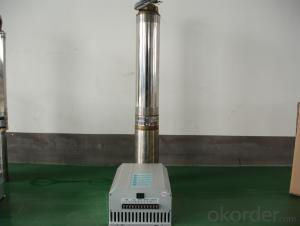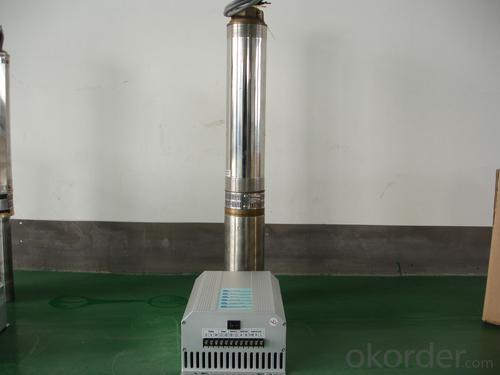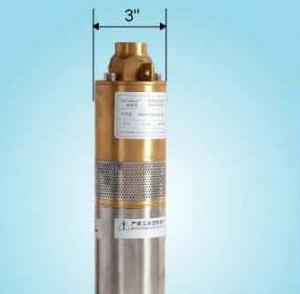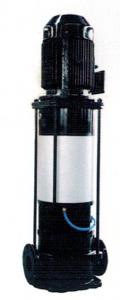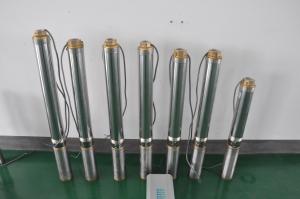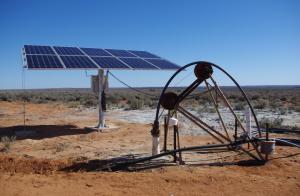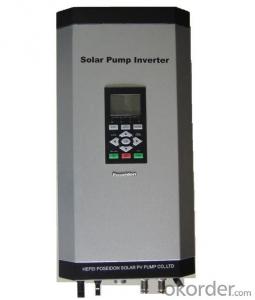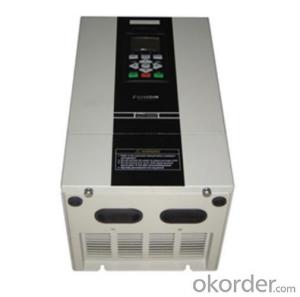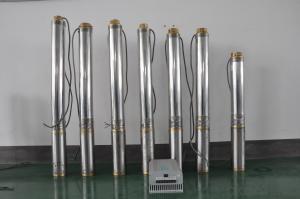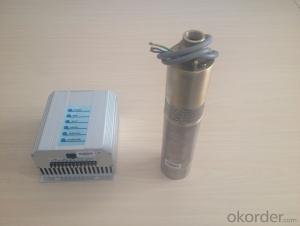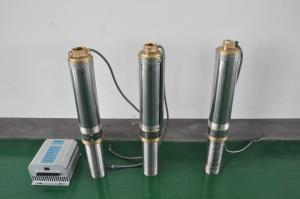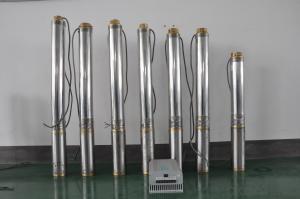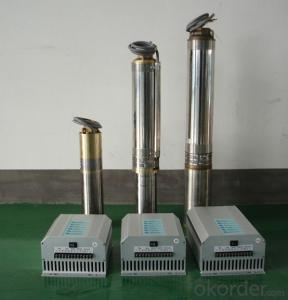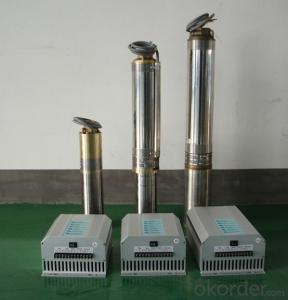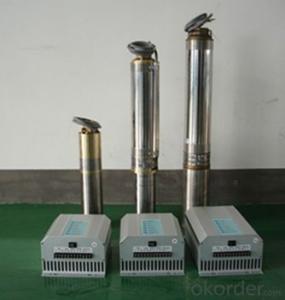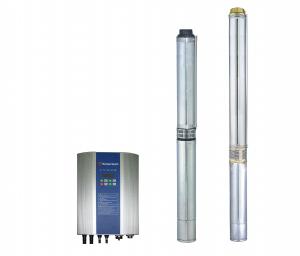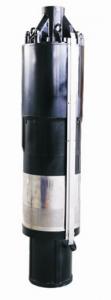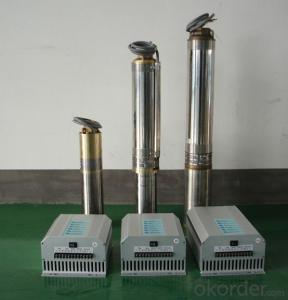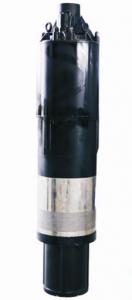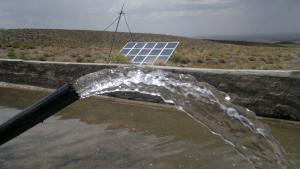Wilo Solar Pump - DC Submersible Solar Water Pump
- Loading Port:
- China Main Port
- Payment Terms:
- TT OR LC
- Min Order Qty:
- -
- Supply Capability:
- -
OKorder Service Pledge
OKorder Financial Service
You Might Also Like
Item Description :
This superb new addition to our solar fountain range comes with a 10w solar panel,and a powerful fountain pump that is capable of producing fountains of up to 2m in height. As well as being easy to set up and use.Instruction manual is supplied for assembly and maintenance.
Solar Fountain Key Features :
Powered by direct sunlight
No high voltage electric mains required
Safe for children
Max. height of fountain: 2M
Max. flow capacity: 800 L/H(176 GAL)
10W Polycrystalline solar panel included
18V DC brushless pump
Solar Pump Features :
Can produce fountains up to : 2M (tube height) 1.4M (fountain height)
Comes with multiple nozzle accessories
Cable Length : 5M
Solar Panel Features :
10W peak power.
Polycrystalline highly efficient solar panel
Comes mounted in aluminium frame
Comes with ground stake and rotating knob so you can angle your panel toward the sun
What You Will Get :
10W solar panel
Solar pump
Ground Sake
Nozzle accessories
Precautions :
DO NOT alter or change the product itself or its components
Operate pump in freshwater only, never above 50 degrees celsius
Keep away from flammable liquids
Do not connect to any other power supply other than the included
- Q: What is the expected efficiency of a solar pump system in converting sunlight to water flow?
- The efficiency of a solar pump system can vary depending on several factors. These factors include the type and quality of the solar panels used, the design and size of the pump system, the geographical location and climate conditions, and the regular maintenance and operation of the system. The type and quality of the solar panels used play a significant role in the efficiency of a solar pump system. High-efficiency photovoltaic panels with advanced technologies are able to convert a larger portion of sunlight into electricity, leading to increased overall efficiency. The design and size of the pump system also impact its efficiency. Efficient pumps with optimized hydraulic designs and suitable flow rates can greatly improve the conversion of electricity into water flow. It is important to properly match the size of the system to the water demand to avoid over or underutilization, which can affect overall efficiency. The geographical location and climate conditions where the solar pump system is installed also affect its efficiency. Areas with high solar irradiation and consistent sunlight throughout the year tend to have better efficiency, as more energy can be harvested from the sun. Regular maintenance and proper operation of the solar pump system are crucial for maintaining its efficiency. Keeping the system clean, free from shading, and well-maintained helps maximize its performance and efficiency. In conclusion, solar pump systems have the potential to achieve high levels of efficiency in converting sunlight to water flow. By using high-quality solar panels, optimizing the design and size of the system, considering the geographical location and climate conditions, and ensuring regular maintenance and operation, these systems can provide a sustainable and environmentally friendly solution for various water pumping needs.
- Q: What are the components of a solar pump system?
- The components of a solar pump system typically include solar panels, a controller, a pump, a storage tank or reservoir, and a distribution network (pipes or hoses) for the water.
- Q: Can a solar pump be used in areas with limited access to backup battery systems?
- Yes, a solar pump can be used in areas with limited access to backup battery systems. Solar pumps work by converting sunlight into electricity to power the pump, eliminating the need for a backup battery system. This makes them ideal for remote or off-grid locations where access to reliable electricity or backup battery systems may be limited.
- Q: Can a solar pump be used for water supply in off-grid fish farms?
- Yes, a solar pump can be used for water supply in off-grid fish farms. Solar pumps utilize solar energy to power the pumping mechanism, allowing for a sustainable and cost-effective solution for water supply in remote locations without access to grid electricity. The solar pump can be used to draw water from a well or other water source and supply it to the fish tanks or ponds, ensuring a continuous and reliable water supply for the fish farm.
- Q: How does a solar pump handle water with high levels of total dissolved solids?
- A solar pump can handle water with high levels of total dissolved solids by utilizing a filtration system. The pump draws water from the source and passes it through a series of filters that are capable of removing or reducing the concentration of dissolved solids. This ensures that the water being pumped is of acceptable quality for various applications, such as irrigation or drinking water.
- Q: How do I maintain the efficiency of a solar pump over time?
- To maintain the efficiency of a solar pump as time goes on, there are several important steps that can be taken: 1. Regularly clean and inspect the solar panels: Dust, dirt, and debris can build up on the panels, causing a decrease in efficiency. Clean them using a soft cloth or brush and ensure that there are no obstructions blocking the sunlight. Routinely inspect the panels for any damage or cracks that may impact their performance. 2. Ensure proper positioning and orientation: Make sure that the solar panels are installed in an area where they receive the maximum amount of sunlight throughout the day. Position them at the optimal tilt and angle based on your location. Regularly check and adjust the panel orientation if necessary to maximize energy absorption. 3. Monitor and maintain battery health: Solar pumps often rely on batteries to store excess energy generated during the day for use during cloudy or low-light conditions. Regularly monitor the battery levels and ensure that they are properly charged. Clean the battery terminals and connections to prevent corrosion. Replace old or damaged batteries to maintain the highest level of efficiency. 4. Check and maintain the pump system: Regularly inspect the pump for any leaks, clogs, or damaged components. Clean or replace the filter to prevent blockages and ensure smooth water flow. If needed, lubricate the moving parts. Routinely check and tighten any loose connections in the pump system. 5. Protect from extreme weather conditions: Solar pumps can be affected by extreme weather conditions such as hail, heavy rain, or freezing temperatures. If possible, install protective covers or enclosures to shield the pump and panels from these conditions. During the winter, drain the pump system and protect it from freezing by using insulation or heat sources. 6. Seek professional maintenance when necessary: If you notice a significant decrease in efficiency or encounter technical issues, it is recommended to seek professional assistance. An experienced technician can diagnose and resolve any problems, ensuring that your solar pump operates at its peak efficiency. By following these maintenance practices, you can prolong the lifespan of your solar pump and ensure its efficiency over time.
- Q: Can a solar pump be used for hydroponic systems?
- Yes, a solar pump can be used for hydroponic systems. Solar pumps are energy-efficient and can be powered by solar panels, making them an environmentally friendly option for hydroponics. They can provide the necessary circulation and oxygenation required for hydroponic nutrient solutions, ensuring proper growth and development of plants.
- Q: How does a solar pump handle power fluctuations or surges?
- A solar pump typically handles power fluctuations or surges by utilizing a built-in inverter or a power optimizer. These components regulate and stabilize the power supply received from the solar panels, ensuring a consistent and reliable flow of electricity to the pump. Additionally, certain solar pumps may incorporate surge protection devices to safeguard against sudden power surges and prevent damage to the pump's motor or other sensitive components.
- Q: Can a solar pump be used for water supply in off-grid RVs?
- Yes, a solar pump can be used for water supply in off-grid RVs. Solar pumps use energy from the sun to power the pump and draw water from a source, allowing for a sustainable and independent water supply in remote locations or off-grid setups. This can be an efficient and eco-friendly solution for RV owners who want to have access to water without relying on traditional power sources.
- Q: How do I ensure the durability of the solar pump system in harsh environmental conditions?
- In order to ensure the durability of a solar pump system in harsh environmental conditions, there are several key steps that can be taken: 1. Equipment selection: Begin by selecting a solar pump system that is specifically designed and rated for the specific environmental conditions you will be facing. Look for pumps and panels that are constructed with high-quality materials to withstand harsh elements. 2. Proper installation: Make sure that the solar pump system is installed correctly by adhering to the manufacturer's guidelines and recommendations. This includes securely placing the panels and pump in a stable and protected location, away from potential hazards or extreme weather conditions. 3. Moisture and dust protection: Harsh environmental conditions often involve moisture and dust, which can cause damage to the system's components. Enclose the pump and control unit in a weatherproof housing or cabinet to shield them from water and dust. Regularly clean and inspect the system to prevent any buildup or damage. 4. Lightning protection: If you are in an area prone to lightning strikes, install lightning arrestors and grounding systems to protect the solar pump system. This will divert any electrical surges away from the system, preventing damage to the panels, pump, and control unit. 5. Regular maintenance: Establish a routine maintenance schedule to ensure the system operates optimally and lasts longer. This includes cleaning the solar panels to maximize energy absorption, checking and tightening connections, inspecting the pump for signs of wear or damage, and promptly replacing any worn-out components. 6. Monitoring and troubleshooting: Utilize monitoring systems to track the system's performance and identify any potential issues. This will enable timely troubleshooting and repair, reducing the risk of major failures and improving overall durability. 7. Proper storage during extreme conditions: If you are aware of impending extreme weather conditions, consider storing the solar pump system by disassembling and storing the components in a safe and secure location until conditions improve. By implementing these measures, you can significantly enhance the durability and reliability of your solar pump system, ensuring it can withstand harsh environmental conditions and continue to operate efficiently for an extended period of time.
Send your message to us
Wilo Solar Pump - DC Submersible Solar Water Pump
- Loading Port:
- China Main Port
- Payment Terms:
- TT OR LC
- Min Order Qty:
- -
- Supply Capability:
- -
OKorder Service Pledge
OKorder Financial Service
Similar products
Hot products
Hot Searches
Related keywords
